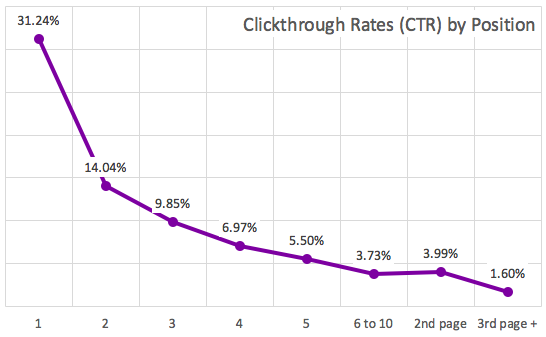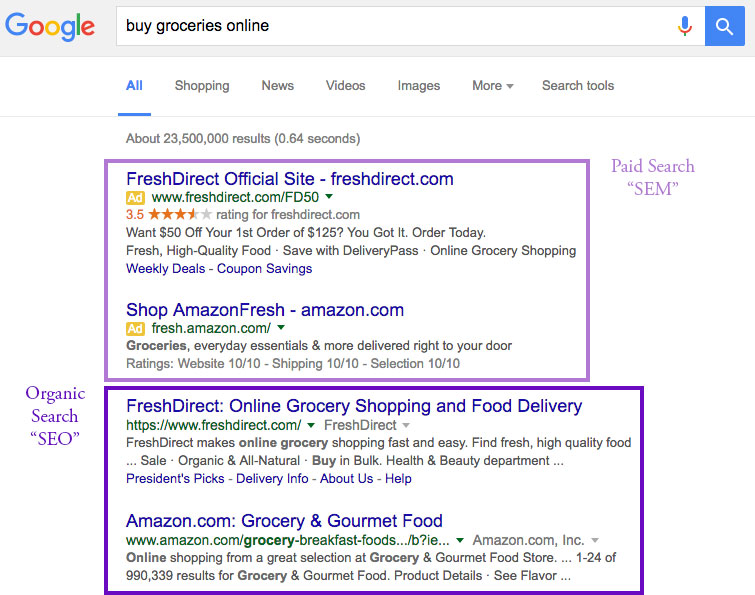Introduction to SEO for Galleries
Welcome to Lesson 1 of SEO for Galleries. This special Gallery Insights series was created by Artsy’s Performance Marketing Team with the hope of demystifying SEO and enabling even the smallest gallery to improve its visibility on Google and other search engines. If you haven’t already done so, you can sign up here to receive the entire series.
What is SEO?
Wikipedia defines Search Engine Optimization (SEO) as:
“the process of affecting the visibility of a website or a web page in a search engine’s unpaid results—often referred to as“natural,”“organic,” or“earned” results. In general, the earlier (or higher ranked on the search results page), and more frequently a site appears in the search results list, the more visitors it will receive from the search engine’s users.”
In short, SEO includes anything you can do to get your website content to show up higher, and more frequently, on search engines like Google. Employing a few strategies and best practices can help your website earn more traffic through organic searches—and more traffic means more leads for your gallery.
What are the most important factors of SEO?
Google’s main ranking algorithm analyzes over 200 factors, so it’s impractical to cover them all. The aim of these lessons is to share the most impactful SEO factors, so that you can see results as quickly as possible. To that end, we will discuss:
- On-site SEO — Perhaps the easiest to influence, on-site SEO covers anything within your control on your website. Generally speaking, this includes content—the text, images, videos, and links that make up your site.
- Off-site SEO — One of the most important areas of SEO, off-site SEO refers to anything outside of your direct control, off of your website. In essence, off-site SEO is about understanding how (and which) other websites are linking to your content, and how to influence those inbound links.
- Technical SEO — Another area that greatly affects rankings on Google, technical SEO relates to the way your site is structured. This includes factors such as your site’s URLs, how fast the pages load, the site’s mobile experience, and more.
In case you’re not familiar with many of these terms (ranks, domains, organic, etc.), we’ll define them throughout the lessons.
So, how does SEO Work?
Google, Yahoo, and Bing each have “robots,” which are programs that continuously browse (or “crawl”) the web, attempting to index as much of it as possible. Usually, this is done by following links from one page to another. These search engine robots (or “bots”) make copies of the pages they find (the “cache”), creating a library of billions of pages on the internet. We will learn more about caching in Lesson 5.
Each search engine attempts to have the most up-to-date “snapshot” of the internet, so that when someone inputs a search (typically called a “keyword” or “query”), it can quickly return the most relevant result based on the information in its cache. When you search for something online, you’re not actually searching the live internet—you’re searching the search engine’s index of it.
The higher your content appears on the search engine results page (SERP), the more often people will click on it. In fact, approximately 30% of all clicks go to the first result on the first page. This placement is also known as rank 1, or position 1. If “Andy Warhol” is searched 100 times, and your site receives 20 of those clicks, it has a 20% click-through rate (CTR) for that search. The graph below shows the average CTR for each position on Google.

Understanding and improving the main SEO factors ultimately helps your website show up more often and higher up in the results, leading to a higher CTR and more visits to your site. This is the main objective of SEO—getting your website in front of more people, leading to more site traffic and more collector inquiries and business.
Paid Search vs. Organic Search
If you’ve ever searched Google, you’ve likely seen both organic and paid search results. “Organic” simply refers to natural, unpaid results, which are the drivers of SEO. “Paid” refers to the results that might look natural, but are in fact ads; these are the drivers of Google’s revenue. You can usually distinguish ads by the small Ad indicator.
Did you know that ~90% of Google’s revenue comes from advertising? One of the largest components of its ad revenue is Google AdWords, a self-service ad platform that lets anyone pay to display their ads alongside organic results. This practice is known as paid search or search engine marketing (SEM). While not the focus of this course, below is some information about SEM in case you’d like to explore this option.
Using SEM, companies can pay to show up at the top of the search engine results page (SERP). Depending on which search terms and keywords you target, SEM can become a very expensive option. Bidding on competitive and commercial searches—such as “buy Andy Warhol prints”—can cost upwards of $2.00 per click. While SEM can be a helpful supplement for a successful SEO program, a key difference with SEO is that your upfront investment will continue to pay off over a longer time frame than with SEM. With paid search, when you stop paying, your visibility disappears.

Today You Learned
- SEO is the process of affecting the visibility of a website or page in organic search results.
- On-site SEO is about optimizing the factors related to your website content, including copy, images, videos, and links.
- Off-site SEO is about optimizing the factors related to inbound links—links to your website from other sites, including press mentions and social media.
- Technical SEO is about optimizing the factors related to the structure and foundation of your website, including URL structures, page load times, and mobile optimization.
- Search engines have “robots” (like Googlebot) that crawl web pages (typically by following links) and create an “index” (library) that can quickly and effectively answer queries or keyword searches.
Next Steps: What are the top searches you’d like to rank for?
- List the top 5 keywords or search terms you would like to rank on page 1 for. (Hint: Your gallery name and top artists are probably most important.)
- Search Google for each of these keywords (see illustration below).
- Each week, note which position you are currently in. This information will be useful for your SEO worksheet at the end of this course.

Sources & Further reading
- Google’s Search Engine Optimization Starter Guide
- Moz’s Beginner’s Guide to SEO and Marketing Academy
- Learn about AdWords: Wordstream
Glossary
- Organic Search: Another way to refer to unpaid search results, often called “natural” or “earned” results, or sometimes also referred to as simply “SEO.”
- Robots (bots): Robots developed by major search engine companies (Google has Googlebot, Yahoo and Bing use Bingbot) that help them browse and index (copy) the web via links, so that when you search for something, a relevant result is returned quickly.
- Crawl: The action of the robots browsing and copying the web.
- Cache: A search engine’s copy of a page at any point in time. As a verb, refers to the process of a search engine crawling and storing a page.
- Keyword: The word or phrase you search for in Google, Yahoo, or Bing.
- SERP: Acronym for search engines results page; what you see on Google, Yahoo, or Bing after searching for a keyword. Results on the SERP are typically displayed in increments of 10—i.e., results 1 through 10 are on “page 1” of Google, results 11 through 20 are on page 2, 21 through 30 are on page 3, etc.
- Rank (rankings): Where on the SERP a website shows up, in order. The higher your rank, the more organic traffic you will receive.
- Click-through rate (CTR): The rate by which people click on your result when it appears on the SERP. For instance, your website might be shown 20 times for a given keyword, and people click on it 5 times out of the 20 times that it appears. This would give you a click-through rate of 25%.
- Paid Search: The paid search ads you see on the SERP (sometimes also abbreviated as PPC or SEM). It is the opposite of SEO as it involves paying a search engine for higher rankings, versus making content or technical optimizations (in organic search).
- Index: A search engine’s copy of all of the pages it has crawled, at any point in time. Similar in concept to a library or filing cabinet.
Congratulations!
You now know what SEO is and what its most important factors are. Next time, we’ll learn about the most important on-site SEO elements, including how to select your target keywords, keyword placement, content targeting, and images.
